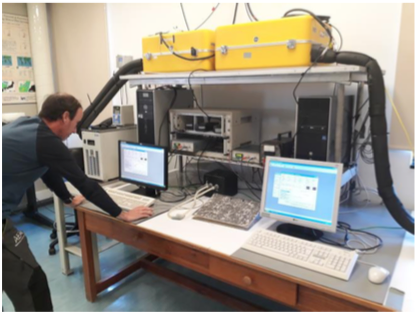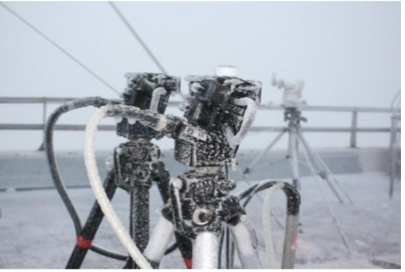Main Scientific Goals
Differential Optical Absorption Spectroscopy (DOAS) and Multi Axis Differential Optical Absorption Spectroscopy (MAXDOAS) techniques allow the determination of atmospheric trace gases present in very low concentrations. The long term monitoring of atmospheric trace gases is of a great interest for trend studies and satellite validation. The detection of gases using DOAS or MAXDOAS technique allows the study of mutual interaction between gases even when detection limits of the gases are low.
The main scientific goals of the DOAS and MAXDOAS programme are:
- To improve the knowledge of the distribution, seasonal behaviour and long term trends of minor constituents related to ozone equilibrium such as NO2, BrO and IO and their distribution in the subtropical atmosphere.
- To obtain a climatology of stratospheric NO2 and BrO in subtropical regions and its dependence on environmental and climatic variables.
- To study the seasonal variation of NO2, O3, formaldehyde (HCHO) and IO in the free troposphere and its interaction with environmental factors such as Saharan dust amongst others.
- To contribute to validation of NO2 and Ozone satellite products (GOME, GOME2, SCIAMACHY, OMI, TROPOMI) and in the improvement of the methodology to perform such comparisons.
Measurement Programme
The DOAS technique is a method to determine the atmospheric trace gases column density by measuring their absorption structures in the near ultraviolet and visible spectral region.

RASAS II and ARTIST II MAXDOAS (UV-VIS) spectroradiometers at IZO.

DOAS instruments outdoor optics with sky trackers.
The technique is based on measurement of atmospheric absorption of solar radiation at selected wavelength bands where the gas under consideration shows a structured and known absorption cross-section. For stratospheric observations the instrument is pointed at zenith during the twilights.
Although the DOAS technique was developed for stratospheric research, during the last few years it has been largely employed in tropospheric environment and pollution episodes studies. In particular, the so called Multi Axis Differential Optical Absorption Spectroscopy approach allows to infer vertical distribution of minor species from spectrometric measurements of solar scattered light at given angles of elevation (off-axis measurements). The analysis technique makes use of the Optical Estimation Method (Rodgers, 2000) by putting together the off-axis measurements and a radiative transfer algorithm to get the best solution for all used elevation angles.
Participation in Scientific Projects and Campaigns/Experiments
Contribution to NDACC data Base
The Network for detection Atmospheric Composition Change (NDACC) (De Mazière et al., 2018) is one of the most important global networks which primary goal is to establish long-term databases for detecting changes and trends in the chemical and physical state of the atmosphere and to assess the coupling of such changes with climate and air quality. INTA, with DOAS measurements of O3 and NO2 at IZO, contribute to NDACC since 1998. Participation in NDACC requires compliance with strict measurement and data protocols to ensure that the network data are of high and consistent quality.
Contribution to CAMS27
The Copernicus Atmosphere Monitoring Service (CAMS) is an integrated service within the Copernicus program that provides information of the atmospheric composition. CAMS27 provides CAMS or high-quality atmospheric data in HDF GEOMS format within a few weeks after acquisition from selected NDACC stations, such as the DOAS measurements at IARC from INTA.
S5P NItrogen Dioxide and FORmaldehyde Validation (NIDFORVal) using NDACC and complementary FTIR and UV-Vis DOAS ground-based remote sending data
This is an ESA proposal (ID28607) led by the Royal Belgian Institute for Space Aeronomy (BIRA-IASB) that started in 2016 and extends to 2024. The aim of this project is to stablish a network of observations supporting validation for tropospheric products of the Sentinel-5 Precursor (Sentinel- 5P). The INTA-MAXDOAS instruments installed at IARC are part of the Sentinel-5P Calibration and Validation Team for NO2.
Aviation and Atmosphere: an Aerospatiale study on aerosols and gases (AVATAR)
AVATAR is a funded Project from the Spanish Ministry of Economy, Industry and Competitiveness (CGL2014-55230- R). This project is mainly focused on analysis of the aerosol impact on climate through the study of the gas-aerosol interaction, study of gas and aerosol distribution in airport areas, aerosol and cloud radiative effects and the performance of comparisons between satellite and ground- based measurements of aerosol.
This project is also focused on the monitoring of the free troposphere and stratosphere with the aim to extend the previous results of AMISOC of the seasonal variation of IO and BrO in the free troposphere. Activities within AVATAR have supported trace gas monitoring and NIDFORVal activities at IARC. This project is operated in collaboration with the In Situ Aerosol Programme.
References
De Mazière, M., Thompson, A. M., Kurylo, M. J., Wild, J. D., Bernhard, G., Blumenstock, T., Braathen, G. O., Hannigan, J. W., Lambert, J.-C., Leblanc, T., McGee, T. J., Nedoluha, G., Petropavlovskikh, I., Seckmeyer, G., Simon, P. C., Steinbrecht, W., and Strahan, S. E.: The Network for the Detection of Atmospheric Composition Change (NDACC): history, status and perspectives, Atmos. Chem. Phys., 18, 4935-4964, https://doi.org/10.5194/acp-18-4935-2018, 2018.
Gil-Ojeda, M., M. Navarro-Comas, A. Redondas, O. Puentedura, F. Hendrick, M. Van Roozendael, J. Iglesias and E. Cuevas. Total ozone measurements from the NDACC Izaña Subtropical Station: Visible spectroscopy versus Brewer and satellite instruments. Quadrennial Ozone Symposium, (QOS 2012). Toronto, Canada. 27-31 August 2012.
Gil-Ojeda, M. Navarro-Comas, L. Gómez-Martín, J. A. Adame, A. Saiz-Lopez, C. A. Cuevas, Y. González, O. Puentedura, E. Cuevas, J.-F. Lamarque, D. Kinninson, S. Tilmes, NO2 seasonal evolution in the north subtropical free troposphere, Atmos. Chem. Phys., 15, pp. 10569-10579, doi:10.5194/acp-15-10567- 2015, 2015
Gil, M., M. Yela, L. N. Gunn, A. Richter, I. Alonso, M. P. Chipperfield, E. Cuevas, J. Iglesias, M. Navarro, O. Puentedura, and S. Rodrıguez, NO2 climatology in the northern subtropical region: diurnal, seasonal and interannual variability Atmos. Chem. Phys. 8, 1635–1648, 2008.
Gomez, L., Navarro-Comas, M., Puentedura, O., Gonzalez, Y., Cuevas, E., and Gil-Ojeda, M.: Long-path averaged mixing ratios of O3 and NO2 in the free troposphere from mountain MAX-DOAS, Atmos. Meas. Tech., 7, 3373-3386, doi:10.5194/amt-7-3373-2014, 2014.
Hendrick, F., J.-P. Pommereau, F. Goutail, R. D. Evans, D. Ionov, A. Pazmino, E. Kyrö, G. Held, P. Eriksen, V. Dorokhov, M. Gil, and M. Van Roozendael, NDACC/SAOZ UV-visible total ozone measurements: improved retrieval and comparison with correlative ground-based and satellite observations, Atmos. Chem. Phys., 11, 5975-5995, 2011.
Pinardi, G., Van Roozendael, M., Abuhassan, N., Adams, C., Cede, A., Clémer, K., Fayt, C., Frieß, U., Gil, M., Herman, J., Hermans, C., Hendrick, F., Irie, H., Merlaud, A., Navarro Comas, M., Peters, E., Piters, A. J. M., Puentedura, O., Richter, A., Schönhardt, A., Shaiganfar, R., Spinei, E., Strong, K., Takashima, H., Vrekoussis, M., Wagner, T., Wittrock, F., and Yilmaz, S.: Erratum: MAX-DOAS formaldehyde slant column measurements during CINDI: intercomparison and analysis improvement (Atmospheric Measurement Techniques (2013) 6 (167-185)), Atmos. Meas. Tech., 6 (2), 219, doi: 10.5194/amt- 6-219-2013, 2013.
Piters, A. et al.: The Cabauw Intercomparison campaign for Nitrogen Dioxide measuring Instruments (CINDI): design, execution, and early results, Atmos. Meas. Tech., 5, 457-485, doi:10.5194/amt-5-457-2012, 2012.
Platt and Stutz, Differential Optical Absorption Spectroscopy, Principles and Applications, Springler, 2008.
Puentedura, O., Gil, M., Saiz-Lopez, A., Hay, T., Navarro-Comas, M., Gómez-Pelaez, A., Cuevas, E., Iglesias, J., and Gomez, L.: Iodine monoxide in the north subtropical free troposphere, Atmos. Chem. Phys., 12, 4909-4921, doi:10.5194/acp-12- 4909-2012, 2012.
Robles-Gonzalez, C., Navarro-Comas, M., Puentedura, O., Schneider, M., Hase, F., Garcia, O., Blumenstock, T., and Gil- Ojeda, M.: Intercomparison of stratospheric nitrogen dioxide columns retrieved from ground-based DOAS and FTIR and satellite DOAS instruments over the subtropical Izana station, Atmos. Meas. Tech., 9, 4471-4485, doi:10.5194/amt-9-4471- 2016, 2016.
Rodgers, C.D., Inverse methods for Atmospheric Sounding: Theory and Practice, World Scientific, Series on Atmospheric, Oceanic and Planetary Physics, Vol. 2, 2000.
Yela, M., Gil-Ojeda, M., Navarro-Comas, M., Gonzalez- Bartolomé, D., Puentedura, O., Funke, B., Iglesias, J.,Rodríguez, S., García, O., Ochoa, H., and Deferrari, G.: Hemispheric asymmetry in stratospheric NO2 trends, Atmos. Chem. Phys., 17, 13373-13389, https://doi.org/10.5194/acp-17- 13373-2017, 2017.
Staff
The DOAS research group is composed of researchers and specialist technicians from INTA and IARC-AEMET.
Dr Margarita Yela González (INTA; Head of programme)
Dr Olga Puentedura Rodríguez (INTA; Research Scientist)
Dr Mónica Navarro Comas (INTA; Research Scientist)
Javier Iglesias Méndez, (INTA; Research Scientist)
Dr Laura Gómez Martín (INTA; Research Scientist)
Ramón Ramos (AEMET; Head of Infrastructure)
